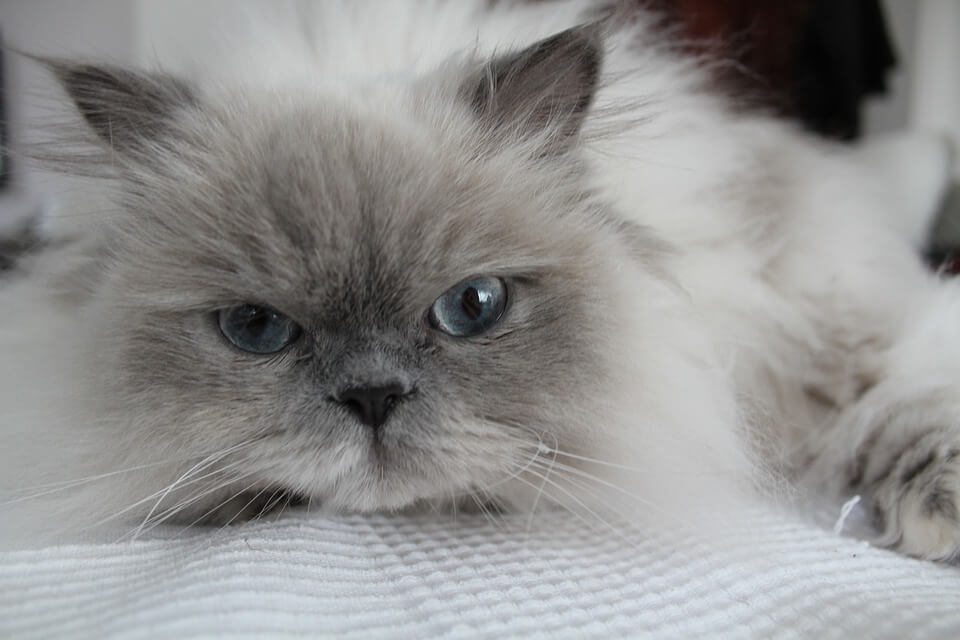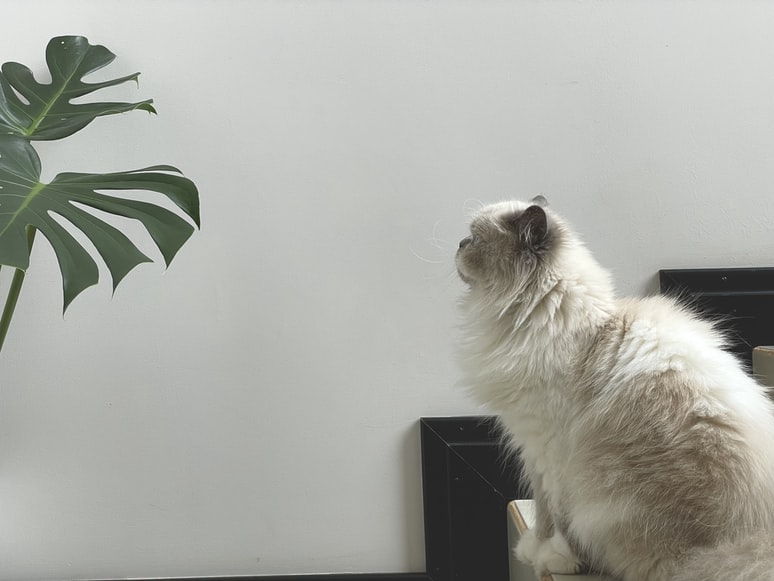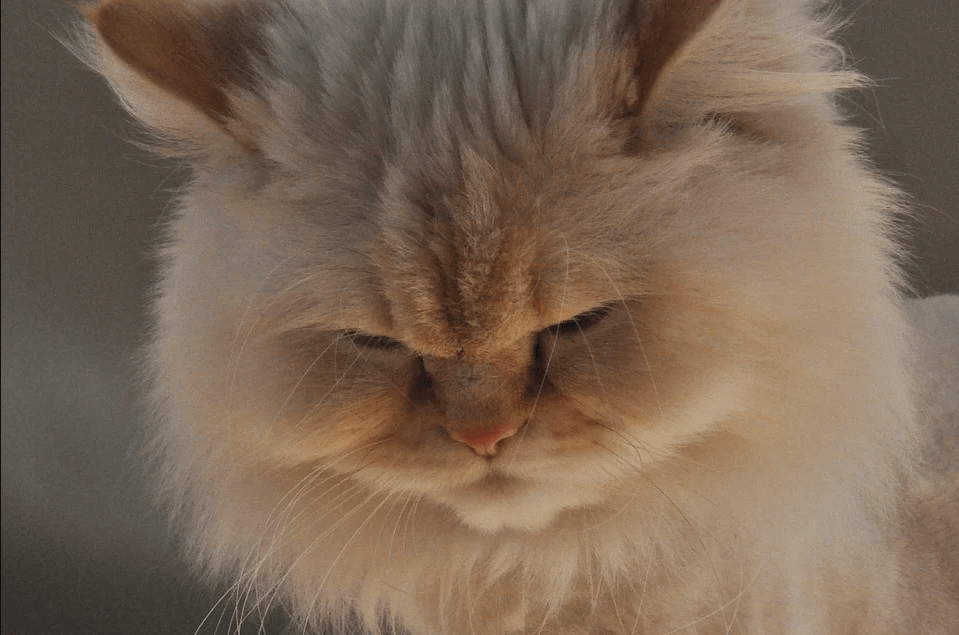Himalayan cat
Himalayan cats, often known as "Himmy" or "Himmies," cross between Persian and Siamese cats. The end product is a lovely cat with long, silky Persian-like hair, Siamese-like pointed coloring and sparkling blue eyes. With the pushed-in face and long, fluffy coat of the Persian and the pointed color pattern of the Siamese, the Himalayan is a charming cat with an eye-catching look. Himalayans have what some consider the greatest features of two well-loved breeds. They have a gentle voice and are nice and calm. They enjoy human attention and get along well with other pets.
Weight
- Male: 7-12 lbs
- Female: 7-12 lbs
Height
- Male: 10-12 inches
- Female: 8-10 inches
Lifespan
- 9-15 years
Appearance

Siamese cats were crossed with Persian cats to create the Himalayans. The Cat Fanciers' Association classified Himalayans as Persian or Colorpoint Longhair. This implies that a Himalayan has many characteristics as a Persian. Persians share the same small legs, round features, and long hair as these cats. The color variations are the chocolate point, blue point, lilac point, cream point, tortie point, or redpoint. The "Siamese" appearance, or seal point, is this breed's most popular and recognized.
A Himalayan's face is unusual in that it can be conventional or extreme, aside from those expressive blue eyes. The traditional face, often known as the doll face, is round and features a longer, lower nose. Extreme, sometimes known as peke-face, is a cute squashy appearance. The Himalayan has a big skull and wide, round eyes. In profile, the face appears flat, with the nose shifting direction such that the pigmented skin on the nose is visible.
Although the boning is thick, the tail is short, and the ears are tiny. The Himalayan has a big skull and wide, round eyes. In profile, the face appears flat, with the nose shifting direction such that the pigmented skin on the nose is visible.
The Himalayan's fine, glossy double coat with those iconic colorpoints is, obviously, cats most striking feature. The majority of their body can be white or fawn, with colorpoint markings in various colors; including Although they are huge and powerfully boned, the Himalayan is generally a medium-sized cat. They might look rather big due to their abundance of fur.
Temperament
Himalayan cats, like their Persian counterparts, are calm and docile. They prefer a sofa to a refrigerator, yet they live quietly and enjoy a range of toys. You should never expect a Himmy to be dormant. They are intelligent, loving, and loyal. A Himalayan considers its pet parent's lap to be a tiny bit of heaven, and while they may be left for extended periods if you must work, they will not hesitate to inform you if you are ignoring them. Their meow, fortunately, has been regarded as melodic.
These cats are shy and want to be in a peaceful environment. If you have children, remember that Himmies enjoy being around youngsters and will even let them push them about in buggies, but they do not enjoy roughhousing. They hate loud noises and are wary of strangers.
Living Conditions

Himalayan cats make excellent family companions, but they prefer a calmer environment. The commotion of a crowded and noisy house is likely to be too stressful for a laid-back Himalayan, especially if it means their sleep time will be disrupted! Gentle, older children get along well with Himalayan cats, especially if they're willing to play with them when your Himalayan cat is in the mood to interact but will leave them alone when they're sleeping or otherwise relaxing.
As long as the canines aren't too demanding, Himalayan cats can get along with them. Most Himmies will not want to play with a dog, but they may be convinced to take asleep with them. When a noisy dog attempts to disturb your Himalayan cat, it may become anxious since they can't get away from them.
Himmies have a low prey drive; thus, they can get along with smaller pets like mice, rabbits, and other small animals. While we never advocate having them in the same room or letting them alone together, maintaining a Himmy with small pets is simpler than keeping other cat breeds.
Himalayan cats are friendly, laid-back felines who spend most of their time resting and lounging. When the mood strikes, they may be fun, but they are not excessively energetic or active. Like any other cat breed, they require daily activity to avoid becoming overweight, which can lead to a cascade of other health problems.
Himalayans are notoriously difficult to motivate to exercise since they dislike climbing, making cat trees inappropriate for this breed. Still, exercise is important, and there are various options to choose from. Getting your cat to play with an interactive toy or ball for at least 20-30 minutes a day is a good idea, and having another cat to play with can also assist.
Care

The Himalayan is probably not the ideal cat for you if you aren't ready to devote some time to grooming each day. A Himalayan's coat should be combed regularly with a robust, wide-toothed comb since they have long, silky hair that tangles and mats readily. This will assist remove any dirt, dust, or debris, as well as tangles and mats. A Himalayan should also see a professional groomer every few months to ensure that its coat is healthy and tidy.
The good news is that Himalayans like receiving attention from their owners, making grooming and bonding simpler for both the owner and the Himalayan. Bathe them once a month to keep their oils in check. Their lengthy hair tends to gather litter in addition to matting. If you don't maintain their litter box clean, this breed may eliminate somewhere else.
Excessive tearing of the eyes is a concern for certain Himalayans. Wash the cat's face every day to avoid unsightly stains, especially beneath the eyes. Trim your nails as needed, which is generally once a week. Every week, check your ears for redness or a foul odor that might suggest an infection. If your ears appear filthy, clean them with a cotton ball moistened with a mild cleaner prescribed by your veterinarian.
Health
Himalayans have several inherited health problems that might be problematic. Polycystic kidney disease (PKD) and respiratory issues caused by abnormalities linked with the flattened face of the breed are among them. Breeders that are responsible take precautions to avoid these issues. Himalayans should be fit and healthy, with normal breathing abilities.
Cat kidney disease is a genetic disorder that causes enlargement and malfunction of the kidneys. Cysts can typically be detected by ultrasonography as early as 12 months, although renal failure may not develop until later. Reputable breeders are establishing PKD-free breeding programs. It is easy to identify and eradicate, thanks to the availability of a DNA test.
Request documentation from the breeder that both of the kitten's parents are clear of kidney cysts, which may be diagnosed via ultrasound or a DNA test. If one of the parents is positive for PKD, which might be the case if the cat's bloodlines are otherwise desirable, be sure the kitten you're buying is PKD negative.
Even if Persians and Himalayans do not have any obvious respiratory issues, their flat faces make them susceptible to heat. They need to live in air-conditioned comfort and be sheltered from the sun.
History

Clyde Keeler and Virginia Cobb, two Harvard academics, agreed to perform a study mixing Siamese and Persian cats in the 1930s. Newton's Debutante was born as a result of their efforts. After its parents, they named it a Siamese – Persian. This lovely feline had a classic look about her.
Colorpoint markings, blue eyes, and a long, silky coat distinguish Siamese Colorpoints. He became one of the first Himalayan Colorpoint Persian cats to represent the breed. Jean Mill, the originator of the Bengal cat breed, began working on the species in 1948 as a cat breeder and conservator.
Brian Sterling-Webb produced the Long-haired Colorpoint, a similar hybrid cat, in 1955. The Cat Fanciers Association recognized Margaret Goforth's continuing efforts to breed Siamese and Persian cats in 1957.
The Himalayan cat breed was named after Goforth. Individual breeders focused on either Persian or Siamese characteristics throughout the following few decades, outcrossing to both Siamese and Persian cats persisted. CFA concluded in 1984 that the Himalayan cat was truly a Persian variation, and many modern Himalayans have more Persian than Siamese characteristics.
All major cat registries recognize Himalayan Colorpoint Persian cats, which use either the Himalayan or Colorpoint Persian names. Despite the labeling confusion between the Himalayan and the Colorpoint Persian, the two breeds are identical.
Final Thoughts
Himalayan cats are incredibly lovely, lively, and sensitive pets that can fit into almost any environment. These cats enjoy being with their owners but aren't excessively demanding their attention. They get along well with other cats and dogs, and they don't have a high prey drive. This is wonderful if you have other small pets at home, but not if you have rat problems!
It's crucial to remember that these cats require a lot of grooming regularly and have several hereditary health issues. This demands commitment, but these cats are low-maintenance in every other aspect. The Himalayan is a fantastic choice if you're searching for a loving, gentle cat to keep around the house.







Comments